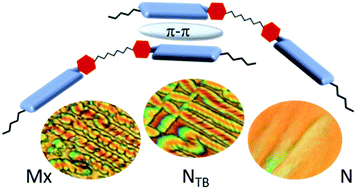当前位置:
X-MOL 学术
›
Soft Matter
›
论文详情
Our official English website, www.x-mol.net, welcomes your
feedback! (Note: you will need to create a separate account there.)
Fine-tuning the effect of π–π interactions on the stability of the NTB phase†
Soft Matter ( IF 2.9 ) Pub Date : 2018-10-09 00:00:00 , DOI: 10.1039/c8sm01569d Anamarija Knežević 1, 2, 3 , Marin Sapunar 1, 2, 3 , Anđela Buljan 1, 2, 3 , Irena Dokli 1, 2, 3 , Zdenko Hameršak 1, 2, 3 , Darko Kontrec 1, 2, 3 , Andreja Lesac 1, 2, 3
Soft Matter ( IF 2.9 ) Pub Date : 2018-10-09 00:00:00 , DOI: 10.1039/c8sm01569d Anamarija Knežević 1, 2, 3 , Marin Sapunar 1, 2, 3 , Anđela Buljan 1, 2, 3 , Irena Dokli 1, 2, 3 , Zdenko Hameršak 1, 2, 3 , Darko Kontrec 1, 2, 3 , Andreja Lesac 1, 2, 3
Affiliation

|
The synthesis and liquid-crystalline properties are reported for novel bent-shaped dimers in which a naphthyl group has been incorporated into the mesogenic cores. In addition to the nematic and twist-bend nematic phase, a new liquid-crystalline phase was observed. The combined experimental and computational study demonstrated how the interplay between the molecular geometry and π–π interactions affects the thermal stability of the twist-bend nematic and nematic phases. Correlation between mesomorphic properties and molecular geometry revealed that a greater conformational diversity leads to a broader distribution of bend-angles and destabilization of the NTB phase. Qualitative correlation between the thermal behaviour and electronic structure of the molecules of a similar geometry suggested that the transition temperatures of both nematic phases depend on the relative contribution of dispersion and electrostatic energies which determines the strength of the π–π interactions. These results provide an insight into how subtle changes in chemical structure can be exploited to tune the intermolecular interactions and influence the thermal stability of the liquid crystalline phase.
中文翻译:

微调π–π相互作用对N TB相稳定性的影响†
报道了新颖的弯曲形二聚体的合成和液晶性质,其中萘基已被并入介晶核中。除了向列相和扭曲弯曲向列相之外,还观察到一种新的液晶相。实验和计算研究相结合,证明了分子几何结构和π-π相互作用之间的相互作用如何影响扭曲弯曲向列相和向列相的热稳定性。介晶性质与分子几何结构之间的相关性表明,更大的构象多样性导致弯曲角分布更广,N TB不稳定阶段。相似几何形状分子的热行为和电子结构之间的定性相关性表明,两个向列相的转变温度都取决于分散和静电能的相对贡献,这决定了π-π相互作用的强度。这些结果提供了关于如何利用化学结构的细微变化来调节分子间相互作用并影响液晶相的热稳定性的见解。
更新日期:2018-10-09
中文翻译:

微调π–π相互作用对N TB相稳定性的影响†
报道了新颖的弯曲形二聚体的合成和液晶性质,其中萘基已被并入介晶核中。除了向列相和扭曲弯曲向列相之外,还观察到一种新的液晶相。实验和计算研究相结合,证明了分子几何结构和π-π相互作用之间的相互作用如何影响扭曲弯曲向列相和向列相的热稳定性。介晶性质与分子几何结构之间的相关性表明,更大的构象多样性导致弯曲角分布更广,N TB不稳定阶段。相似几何形状分子的热行为和电子结构之间的定性相关性表明,两个向列相的转变温度都取决于分散和静电能的相对贡献,这决定了π-π相互作用的强度。这些结果提供了关于如何利用化学结构的细微变化来调节分子间相互作用并影响液晶相的热稳定性的见解。











































 京公网安备 11010802027423号
京公网安备 11010802027423号